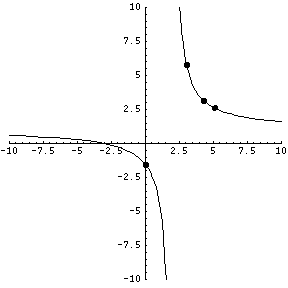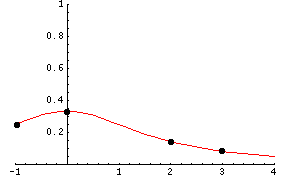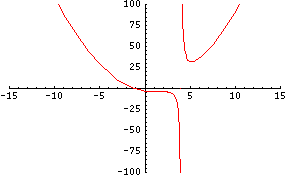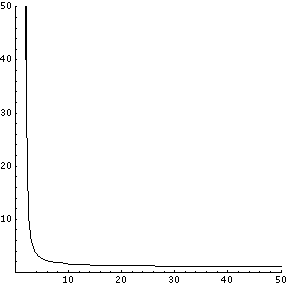Graph some more complicated functions
Background
Graphs of normal polynomials are always unbroken lines or smooth curves. Rational functions, by contrast, sometimes have breaks which separate the graph into two or more disconnected pieces. A break in the graph of a function is called a discontinuity. Think about it as a gap on the road you are driving.
Polynomials have no breaks or discontinuities because they deal mainly with the process of addition, subtraction and multiplication. Rational functions deal with the process of division. Division makes room for discontinuity to take place in the graph of the function, particularly in places where a division by zero exists. Before we go on, it is vital for you to remember that division by zero is undefined or does not exist. In other words, a fraction cannot have zero in the denominator. Here are three samples of fractions that are undefined: 5/0, 12/0, x/0 and/or any other fraction which has zero in the denominator. The equation \(y=\frac{5}{x-1}\) is undefined at exactly one place: when \(x=1\).
Example A:
Graph: \(f(x) = \frac{(x + 3)}{(x-2)}\)
In this case, x CANNOT = 2 in the denominator because it will create division by zero. If x = 2 in the denominator of the above fraction, there will be a break or discontinuity in the graph or picture of the function.
How to graph the above function:
1) Create an (x, y) table.
2) Select different values for x OTHER THAN x = 2.
3) Use algebra to simplify the fraction.
4) Graph each point on the xy-plane. NOTE: The xy-plane is also called the Coordinate Plane. This idea is taught in geometry.
I will select the following 4 values for x: 0, 3, 4 and 5.
When x = 0, y = -3/2
When x = 3, y = 6
When x = 4, y = 7/2
When x = 5, y = 8/3
Here are the four points in (x, y) form:
(0, -3/2), (3, 6 ), (4, 7/2) and (5, 8/3)
After graphing all four points, the graph will look like this:

NOTE: There are functions with squares, cubes, etc that will NEVER yield division by zero regardless what values we decide to select for x. The squaring and cubing process will do away with division by zero.
Sample B:
Graph: f(x) = 1/(x^2 + 3)
Again, follow the steps given in Sample A.
I decided to select the following 4 values for x: 0, -1, 3 and 1/2.
When x = 0, y = 1/3
When x = -1, y = 1/4
When x = 3, y = 1/12
When x = 1/2, y = 4/13
This is what our function looks like: 
A break in the graph of the function can happen in two ways:
1) A Missing Point (also called Removable Singularity or Discontinuity).
2) Asymptotes. I will discuss asymptotes in math lesson: Graphing Rational Functions... Part 2.
Sample of Missing Point:
In the function y = x^2 - x + 12/(x - 4), if x = 4, there is discontinuity or a gap in the graph of the function because when x = 4, division by zero is the result.
Here's what the above graph looks like when x = 4:

When facing division by zero, I can factor the numerator and denominator of the fraction. I will now factor the above fraction. Why factor? After factoring, I'll be able to select ANY value for x in terms of making a graph without removable singularity.
y = x^2 - x + 12/x - 4
y = ( x- 4) ( x + 3)/x - 4
y = x + 3
In the equation y = x + 3, I can select ANY value for x to find points in the (x, y) form.
Review:
The first type of break is known as REMOVABLE SINGULARITY, which is a missing point on the graph of the function. Removable singularity takes place when a chosen value for x leads to division by zero. If you factor and then simplify the rational function, division by zero can be avoided.
Asymptotes: An Introduction
In the function f(x) = (x + 3)/(x - 2), x CANNOT equal 2 because it would yield division by zero in the denominator, which does not exist. But what happens when x almost equals 2?
For example, in the sample above, if x = 2.3, then this will happen:
y = x + 3/x - 2
y = 2.3 + 3/2.3 - 2
y = 5.3/0.3
y = 17.66
At x = 2.2, y = 26, etc.
We can see here that as the value of x decreases, y increases. The closer x will get to 2, the bigger y will be. Of course, the opposite is also true. As x increases, y decreases.
Geometrically speaking, there will be a near-vertical line that appears as x gets closer to 2. It will approach, but never actually touch, x=2. The vertical line x=2 is called the asymptote. Here is an illustration:

Asymptote on the right upward side of the vertical line looks like this:

The above pictures represent vertical asymptotes. Both asymptotes get closer to 2 but never quite reach the vertical line at point (2, 0 ).
There are many more pictures of asymptotes. Look for them in future lessons.
Provided by Mr. Feliz
